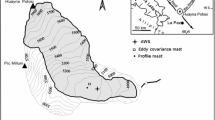Abstract
Studies involving radar remote sensing or modeling of the ocean/Marine Atmospheric Surface Layer (MASL) interface demand a thorough description of how coherent convective structures couple the two mediums together. The current analysis provides this information for the small-scale variability caused by boundary-layer convection. NCAR Electra 50 m above mean sea level (MSL) turbulence data from Project FIRE (First ISSCP [International Satellite Cloud Climatology Program] Regional Experiment) are conditionally sampled and composited to produce horizontal planviews of the typical perturbation horizontal wind field within these convective updrafts and downdrafts. Applications of these observational results, as well as similarly derived flux data from Sikora and Young (1993), to the above mentioned studies, are then discussed.
Similar content being viewed by others
References
Albrecht, B. A., Randall, D. A., and Nicholls, S.: 1988, ‘Observations of Marine Stratocumulus Clouds During FIRE’,Bull. Amer. Meteorol. Soc. 69, 618–626.
Beal, R. C.: 1980, ‘Spaceborne Imaging Radar: Monitoring of Ocean Wavers’,Science 208, 1373–1375.
Fairall, C. W., Ebson, J. B., Larsen, S. E., and Mestayer, P. G.: 1990: ‘Inertial-Dissipation Air-Sea Flux Measurements: A Prototype System using Realtime Spectral Computations’,J. Atm. and Ocean. Tech. 7, 425–453.
Fu, L. L. and Holt, B.: 1982, ‘Seasat Views Oceans and Sea Ice with Synthetic-Aperture Radar’,Jet Propulsion Laboratory Publication 81–120.
Hasselmann, S., Hasselmann, K., and Bauer, E. (and the Wave Model Development and Implementation Group), 1988: The WAM Model — A Third Generation Ocean Wave Prediction Model’,J. Phys. Oceanogr. 18(12), 1775–1810.
Khalsa, S. J. S. and Greenhut, G. K.: 1985, ‘Conditional Sampling of Updrafts and Downdrafts in the Marine Atmospheric Boundary Layer’,J. Atmos. Sci. 42, 2550–2562.
Kloesel, K. A., Albrecht, B. A., and Wylie, D. P.: 1988, ‘FIRE Marine Stratocumulus Observations-Summary of Operations and Synoptic Conditions’, Penn State University, Department of Meteorology, FIRE Technical Report No. 1.
Liu, W. T., Katsaros, K. B., and Businger, J. A.: 1979, ‘Bulk Parameterization of the Air-Sea Exchanges of Heat and Water Vapor Including the Molecular Constraints at the Interface’,J. Atmos. Sci. 36, 1722–1735.
Moyer, K. A. and Young, G. S.: 1991, ‘Observations of Vertical Velocity Skewness Within the Marine Stratocumulus-Topped Boundary Layer’,J. Atmos. Sci. 48, 403–410.
Nucciarone, J. J. and Young, G. S.: 1991, ‘Aircraft Measurements of Turbulence Spectra in the Marine Stratocumulus-Topped Boundary Layer’,J. Atmos. Sci. 48, 2382–2392.
Sikora, T. D. and Young, G. S.: 1993, ‘Observations of Planview Flux Patterns within Convective Structures of the Marine Atmospheric Surface Layer’,Boundary-Layer Meteorol. 65, 273–288.
Stull, R. B.: 1988,An Introduction to Boundary Layer Meteorology, Kluwer Academic Publishers, Dordrecht.
Wilczak, J. M.: 1984, ‘Large-Scale Eddies in the Unstably Stratified Atmospheric Surface Layer. Part I: Velocity and Temperature Structure’,J. Atmos. Sci. 41, 3537–3550.
Author information
Authors and Affiliations
Rights and permissions
About this article
Cite this article
Sikora, T.D., Young, G.S. Observations and applications of the horizontal perturbation wind field within convective structures of the marine atmospheric surface layer. Boundary-Layer Meteorol 68, 419–426 (1994). https://doi.org/10.1007/BF00706799
Revised:
Issue Date:
DOI: https://doi.org/10.1007/BF00706799




